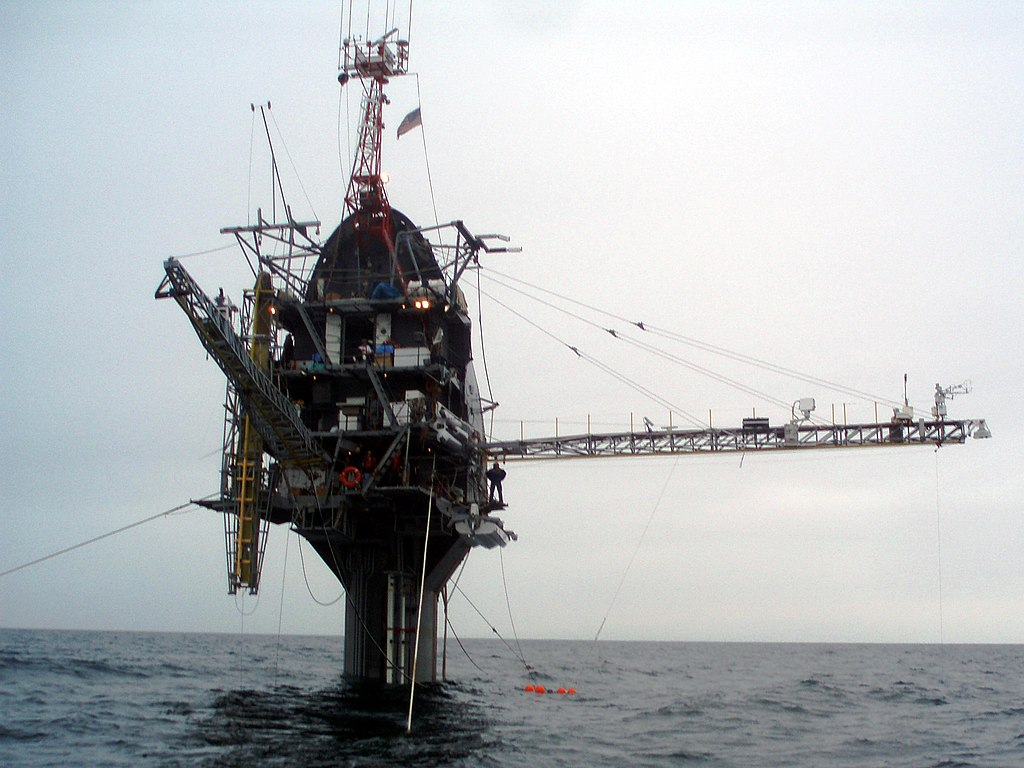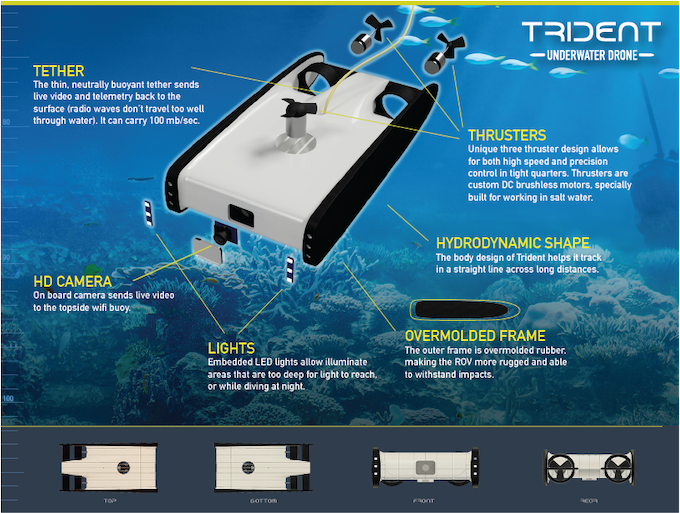
This post is published on the 120th anniversary of the founding of the Marine Biological Association of San Diego on 1903-09-26. In 1912, the assets of this organization were transferred to the Regents of the University of California and renamed the Scripps Institution for Biological Research. In 1925-10, it was renamed the Scripps Institution of Oceanography.
Its mission statement reads, “To seek, teach, and communicate scientific understanding of the oceans, atmosphere, Earth, and other planets for the benefit of society and the environment.”
One of the more interesting vessels at Scripps was Research Vessel Flip = Floating Instrument Platform. It was in service from 1962-07-23 to 2023-08-04, but is now being scrapped. It is often described as an open ocean research platform designed to study various phenomena such as wave height, acoustic signals, water temperature and density, and to collect meteorological data. The vessel has no means of propulsion, because that could potentially interfere with acoustic instruments. Surprisingly, it is equipped with diesel generators. Flip has to be towed to open water sites where it will be used. Once it is in position it is sunk, reaching a depth of 91.4 m. Part of the vessel remains above the waterline, up to a height of about 17 m above the surface. It can then either be allowed to drift freely, or is anchored in place.
For the past sixty years, I have followed the adventures of Flip at irregular intervals, inspired by its ability to collect data. A cheaper way of collecting data is to use a smaller vessel equipped with sensors. Since 1962 there has been major developments in sensor technology. Sensors are now inexpensive, and can be attached to microprocessors. Data can be stored on equally inexpensive solid state devices, that can be fitted onto an underwater vessel.
In robotics, as elsewhere, language is used inconsistently. There are two types of underwater robots, that is, underwater vessels/ vehicles without human occupants, that use two different naming conventions. If the robot is tethered to the surface it is called a ROV = Remotely Operated Vehicle. If it isn’t, it is called an AUV = Autonomous Underwater Vehicle.
In a more ideal world, it should be possible to distinguish between surface watercraft and submersible watercraft. Both categories could be autonomous or in some way human controlled. Tethered craft are not crewed, but remotely controlled by humans. An alternative naming system could refer to two classes of robotic submersibles, the first referred to as tethered (RS-T), and the second as autonomous (RS-A) or even untethered (RS-U). A vessel crewed with humans could be given the name CS = crewed submersible.
My experience with RS-Ts started in 2008 teaching technology to students at Leksvik Upper Secondary School, and using both the community swimming pool and a local beach as launch sites. Build Your Own Underwater Robot and Other Wet Projects (1997) by Harry Bohm (1954 – ) and Vickie Jensen (1946- ), published by Westcoast Words, in Vancouver, provided the inspiration. A copy of this book was found at the Simon Fraser University bookstore, and purchased in the summer of 1997.
Experimentation with a diving bell, teaches the laws of physics as they apply to submersibles. Depending on the power of the airpump, a diving bell is able to rise, fall and even balance itself in a column of water. However, if the diving bell descends below a certain critical depth, the water pressure will be too great for the air pump to work, and the vessel will continue downward without any ability to stop. This surprises most students.
Three of their models, a Diving Bell (powered by an aquarium airpump), Seaperch (powered by thrusters = electric motors) and Seafox (powered by bilge pumps) were made, adapted and remade, repeatedly.
There are numerous commercial and organizational sites that use the Seaperch and/ or Seafox as the starting point for products, competitions and DIY construction. Unfortunately, some are disingenuous, most notably the Seaperch organization, that fails to acknowledge their indebtedness to Bohn/ Jensen. However, the Wikipedia article about the organization does acknowledge this debt. The Bohm/ Jensen RS-Ts have their limitations, particularly in terms of operational depth. Their main purpose is education, both in terms of construction and operation in a marine environment.
Monitoring Equipment
An infinite number of inmates at Verdal prison had, over the years, requested an opportunity to make drones. In particular, they were interested in using these to monitor prison guards. Fortunately/ unfortunately for the guards/ inmates, respectively, no drones were ever made at the prison, at least not when I was working there. When I did offer to teach them how to make underwater vehicles, there was no interest.

Thus, when OpenROV was proposed in 2012, it immediately attracted my attention. It took several years (2015), before OpenROV announced a Kickstarter project to build an underwater drone for everyone. They referred to it as Trident, with a purchase price of $1 200 each.
With a length of 300 mm, a width of 200 mm and a height of 150 mm, it is considerably smaller than either a Seaperch or Seafox. It is also lighter, with a mass of about 2.5 kg. However, it has several additional attributes that distinguish it. The first is an ability to reach a depth of 100 m. This makes it almost useful! The depth exceeds that of RV Flip.
A waterproof tube 180 mm long and 100 mm (outside) diameter houses all the electronics and other environmentally sensitive equipment. There are 3 x 800kv brushless motors to power the RS-T. Two horizontal thrusters allow the RS-T to move forward and aft as well as rotate, and a vertical thruster allows the (neutrally buoyant) vehicle to change depth.
The trident is the weapon of the gods of the Sea: Greek Poseidon, or Roman Neptune as well as Amphitrite, Greek queen of the sea and consort of Poseidon. In Roman mythology she is referred to as Salacia, with a reference to salt. In both sets of myths, Triton, another Greek as well as Roman god of the sea, is the son of Poseidon/ Neptune and Amphitrite/ Salacia. Triton is a merman with a human upper half, and a fish/ lobster/ crayfish lower half. In Hinduism, Shiva also uses a trident, referred to as a trishula.
Ægir (Æge in modern Norwegian) is the Norse god of the sea. He does not appear to have a weapon, but spends his time brewing beer. He is married to Rán (Rån in modern Norwegian), goddess of the sea. Together they have nine daughters, the waves.
One of my intentions when I worked at setting up a mechatronics workshop in Inderøy, was to provide an opportunity for the production of equipment to monitor the environment. At the time I was particularly interested in unmanned underwater vehicles, to discover local sources of pollution. Inderøy library has now taken over this workshop.
Thus, my own little workshop will have to become a local skunk works, producing not only vessels, but slower, lower altitude incarnations of a U-2 Dragon Lady or SR-71 Blackbird, in the form of a drone.
Lockheed took the name Skunk Works from Li’l Abner’s moonshine factory, where it was known as Skonk Works, found in the comics written and drawn by Al Capp (1909–1979), from 1934 to 1977. For those too young to be acquainted with the comic strip, Li’l Abner Yokum, was the son of Pansy Hunks aka Mammy Yokum and Lucifer Ornamental Yokum aka Pappy. They lived in a log cabin in Dogpatch, USA. The location of Dogpatch is disputed, but most place it in Kentucky. One of the wimmenfolk there was the beautiful Daisy Mae Scragg, who married Abner in 1952. Sadie Hawkins was another notorious resident, not quite so beautiful, but intent on marrying. Some of my fascination with names as well as fictitious geography comes from comic strips. In addition to Li’l Abner, Pogo by Walt Kelly (1913-1973) also provided some interesting geographical features in Okefenokee Swamp, located in southern Georgia and northern Florida.
Currently, I have a workshop that supports my construction activities by producing components in wood. While I have not given up the idea of producing wooden products entirely, especially geodesic dome greenhouses, I have also acquired a small computer numeric control (CNC) milling machine, for subtractive processes. One intended use of this machine is to make parts for a RS-T. I also have a 3D-printer for making parts using additive processes.
In the past, I have used the non-descriptive name, Unit One, for this workshop. My own name, Brock, means badger, so it is not inappropriate to rename this workshop the Badger Works, but also incorporating the Norwegian language equivalent, Grevlingverket. From 2024-01-01, I intend to spend time designing and making a RS-T and surface/ support unit, suitable for investigating pollution in Trondheim fjord. The names Ægir and Rán will probably be incorporated into the names of these vessels.


My favorite Pogo line is, “We have met the enemy and he is us!”
My favorite Lil’ Abner character was a small fellow who was followed wherever he went by a small cloud that rained only on him … I think we all know folks like that!
Yes, Art, I agree, that is Walt Kelly’s best quotation. His second best is: We are confronted with insurmountable opportunities.
Unfortunately, not everyone sees the world in this way, especially not Joe Btfsplk, the character living under a cloud, in Li’l Abner. For more information about Joe see: https://en.wikipedia.org/wiki/Joe_Btfsplk